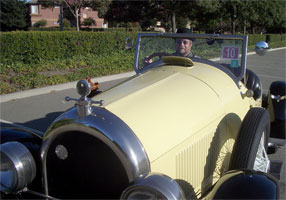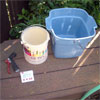
The Serious Freshening
Go to <Last, Summary, Next>Cooling—Measuring Radiator Flow Rate
 Lynn in Bugsby, September 5, 2005 |
Completed: 2006-07-16 — Started: 2006-07-16
 |
 |
| RADIATOR FLOW RATE: Bugsby's radiator can handle all the water that Lynn's garden hose can deliver (left). Using a bucket and a timer (right) Lynn determines that the hose is delivering about 7 GPM. |
Work Completed:
When Lynn is describing the early cooling problems with Bugsby to
Ken MacKinnon, Ken asks Lynn a darn good
question, what is the flow rate through the radiator?
Lynn had flushed and reverse flushed the radiator, but he had not really paid that close attention
to the flow rate.
How would you measure it?
This is the just the kind of didactic problem that Lynn loves to explore.
(See the 2009 Bugsby Adventure "Measuring Radiator Flow Rate with Simple Tools" for a more elegant solution to this question.)
Lynn plans to adjust the flow from his garden hose to match the throughput of the radiator, opening the water valve until the radiator just starts to overflow. Unfortunately the radiator can take as much flow as the garden hose can deliver. (Actually Lynn doesn't feel that bad about this because it means that the radiator is can actually handle a darn good flow rate.)
Using a old gallon paint can, Lynn uses a kitchen timer to measure how long it takes to fill it with his garden hose running at maximum. Repeating the measurement a couple of times, Lynn finds that it takes 8-9 seconds, a flow of right around 7 gallons per minute.
So Lynn still doesn't know exactly what the flow rate of Bugsby's radiator is, but he knows that it is more than 7 GPM and he thinks that this is good enough to keep the old boy cooled.
Work Remaining:
None.
Contact
 with your comments or questions
with your comments or questionsCopyright © 2018 Lynn Kissel
Last updated: August 21, 2013